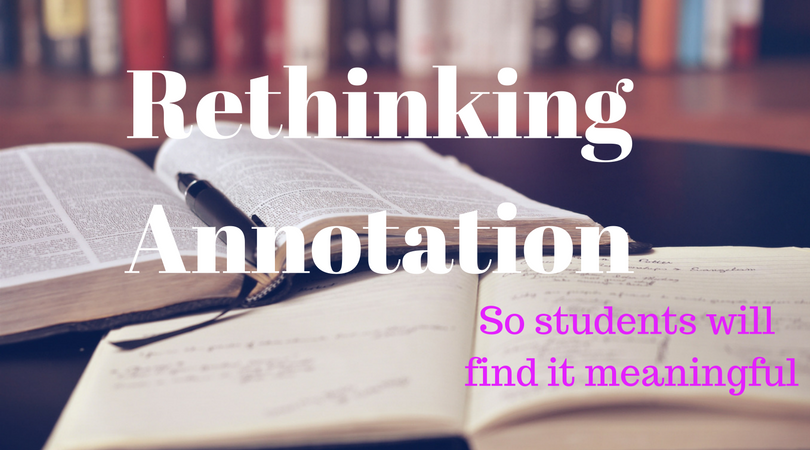 Most of my students don’t like to annotate, and it’s because teachers have made it that way. We’ve used annotation to turn reading into work – and unpleasant work at that. We all agree that annotation is a valuable skill, but too many of our students tell me that annotation makes them like reading less. And I’m concerned that for my students, it’s the reason why they stop reading for pleasure. If something we do is killing students’ love of reading, we should reexamine it.
Most of my students don’t like to annotate, and it’s because teachers have made it that way. We’ve used annotation to turn reading into work – and unpleasant work at that. We all agree that annotation is a valuable skill, but too many of our students tell me that annotation makes them like reading less. And I’m concerned that for my students, it’s the reason why they stop reading for pleasure. If something we do is killing students’ love of reading, we should reexamine it.
Let me tell you how I taught annotation when I first started teaching it as a skill. I can’t believe I did it this way. In order to get full credit, students had to:
- Have some sort of comment and highlight on every page.
- Have a summary of the action on that page at the top.
- Have a chapter summary at the end of each chapter.
- Have a detailed character list at the beginning.
- Have a list of themes at the end.
All of these of course are worthy endeavors, but took up way too much time. And students found themselves focusing too much on what they had to do while they were reading and not enough time on reading itself.
Let’s be clear: we want our students to be active readers, and annotation certainly helps with that. But our goals should be that it should be something that students don’t mind doing, a natural extension of reading something that you are going to discuss or write about. For too many students, annotation is something that they do for teachers and not for themselves.
So how can we change what annotation looks like in our classroom to make it more mindful and meaningful?
Don’t have students annotate all the time.
Give them a few chapters that they can read for enjoyment. Really zero in on those passages where a close read will give students the most bang for their buck and have them annotate those.
Don’t treat annotation as a way to force students to read.
It might work. But we might be sacrificing the love of reading in the process. We want annotation to help students understand something better, and not use it as a method to outwit those who otherwise would choose not to read.
Give students something to look for.
Rather than giving vague goals like “put a comment on every page,” or “underline important stuff,” give students a clear task. Perhaps you want them to examine direct and indirect characterization. Maybe the author’s use of tone. The first chapter is a great place to annotate with this simple question: what will this book be about? And if you already know because the back cover gave too much away, how are those ideas set up in the beginning? Students can also have a choice of one of a few things to look for that might interest them.
Put away the highlighters.
I got this suggestion from Jori Krulder at aplithelp. She suggests putting away the highlighters – at least at first – because it’s too easy to just highlight without thinking about the text. She emphasizes that annotation is the stuff you write in the margins and not the stuff you highlight or underline. Simply underlining or highlighting does not promote you to think about what you’re reading.
Use the annotations in class.
I’m basically done with coming up with questions for class discussions this year because I want the students to take ownership of their learning. This year I’m really going to focus on having students come to class with something interesting to say. Annotation can be a tool they can use to be prepared to start talking about what we’re reading.
Make it Fun!
Annotation can be at least moderately fun if you have the students create their own secret codes for their annotations or allow them to draw instead of write. Occasionally give them something fun to do, like count the number of times the author uses the word “supposedly.” All of these suggestions come from this post at We Are Teachers, and they have a cool infographic you can download too.
Try it in Pairs.
This suggestion comes from April Smith. She has her students annotate a passage in pairs and discuss what they found. Not only does this help those who struggle with the task, but it allows for a richer understanding of the passage as student share ideas.
Strike a balance.
A good thing to contemplate as you assign annotating is: how much time should students spend annotating versus reading? This will vary from teacher to teacher and task to task, but I suggest that the majority of time should be spend reading. I think a goal of 80% reading to 20% reading is realistic and won’t overwhelm the students.
David Rickert is a high school English teacher in a suburb of Columbus, Ohio. He has been teaching for over 20 years and has taught virtually every grade and every subject. David is passionate about developing lessons that make difficult language arts subjects fun and engaging. He is also an author on Teachers Pay Teachers.




